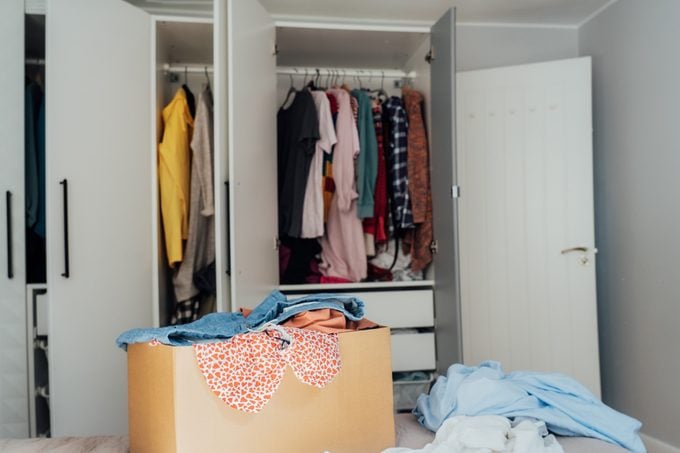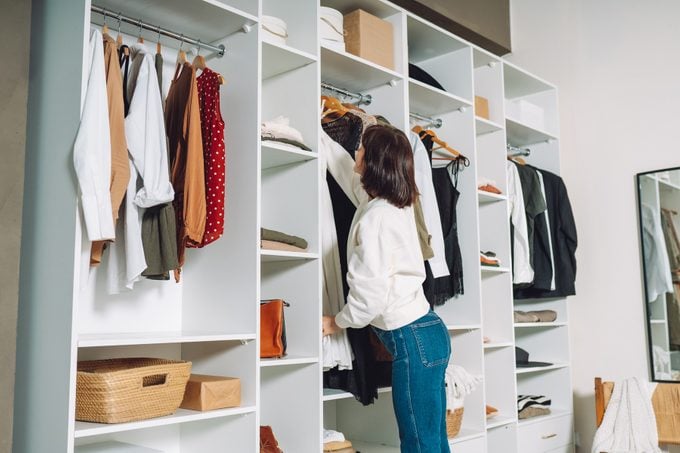Five decluttering pros share their time-tested tips for opening up your closet space, and in turn, freeing up your mind.

5 Tips for Decluttering and Organizing Your Closet

A jammed-up closet is not just an eyesore; it’s a stress-maker. But chances are you only wear a small percentage of those duds, which means decluttering your closet isn’t as daunting a task as it sounds—and the result will be freeing.
“Having a closet that only has the items you love, where you can find everything easily, is like a welcome hug in the morning. It can help you start off your day in a positive frame of mind,” says Michele Vig, founder of Neat Little Nest.
If you’ve been yearning for a streamlined closet, here’s how to master the decluttering process with tips from five master organizers.
On This Page
Why You Should Declutter Your Closet
Decluttering your closet, or any space, makes it easier to find the resources you have, plus it reduces anxiety. It also saves you money and helps you become more sustainable, by helping you avoid buying things you don’t need.
“When we accumulate excess, we’re often contributing to overconsumption, which places unnecessary strain on the planet’s resources,” says Ben Hardman, creator of Tiny Eco Home Life. “By thoughtfully downsizing, you’re not only simplifying and minimizing your life, but you’ll also be reducing your environmental footprint over the long term.”
Tips for Decluttering Your Closet
Studies show that we wear about 20% of our clothing 80% of the time, so the ultimate goal of decluttering your closet is to get to the point where you like and wear every item inside, says Courtney Cummings, founder of The Stylish Organizer. Here’s how to accomplish that.
Pull everything out
Yes, every last bit. “Seeing all that you own will have a big visual impact when brought together,” says Julie Leonard, a certified life and decluttering coach.
Spread everything out, including clothing and accessories not stored in your closet, so you can see the full extent of what you’re dealing with. As you pull out your clothes, separate them into categories like jeans, dress pants, blouses, etc. You can also use this as an opportunity to dust the shelves and vacuum before putting your clothes back in.
Edit by category

Focus on one category of clothing at a time, such as T-shirts or skirts, systematically weighing the importance of each item. “That way, you don’t end up keeping twelve pairs of light khaki pants or five black cardigans,” says Cummings.
To decide what to keep, ask yourself:
- Do you wear it? If you haven’t in the past year (or two for winter garb), it’s probably time to let it go.
- Does it fit? Try it on, and if it doesn’t, it’s time to part ways. “Clear out space for clothes you’ll actually wear, and stop holding onto things ‘just in case,” says Tina Priestly, CEO of Ready, Set, Refresh.
- Can you store it? Consider storing seasonal clothes and shoes in temporary storage during the fall and winter months, says Elizabeth Dodson, co-founder of HomeZada.
- Does it make you feel bad? “Perhaps you associate an item with a bad time in your life,” says Leonard. “Maybe you don’t like the texture, or it was expensive and then you never wore it? All of these items should go.”
- Is it impractical? Be ruthless with these, says Leonard. “Those boots that rub your heel, the top that is see-through, the dress that doesn’t fit well, you will never wear them.”
- Is it stained or damaged? Keep a few for rags, but the rest goes.
- Do you have duplicates? You probably don’t need 10 pairs of jeans.
- Does it resonate with you? It’s ok to let it go, even if it was a gift. Someone else will enjoy it more.
- Do you like to color? If not, you will never feel your best in it.
- Will you actually mend it? If you’re not ever going to fix those ripped jeans, it’s probably time to let them go.
- Is it clothing or a keepsake? “I love my concert t-shirts and have some I’ve had for decades,” says Leonard. “Keep this memorabilia, but store it in a memory box, not in your wardrobe.
- What are you saving it for? Don’t wait for a special occasion. Either sell it or use it. “Wear your good underwear or that cashmere jumper and feel your best,” says Leonard.
Create a maybe pile
Don’t let indecision hinder your progress. Create a “maybe” pile to revisit after you have gone through everything, says Leonard. You may be more ruthless the second time around.
“Or hang your clothes with the coat hangers facing the same way and when you wear an item, turn the coat hanger the other way,” says Leonard. “After six months, see which clothes you wear.”
Go through it again
Cummings suggests sorting through your keep pile one more time to double-check your thoughts on each piece. “Then, you have done it!” she says. You have now intentionally gone through each item in your closet and determined what will be allowed back in. That deserves a gold star!”
Sort the purge
Put the clothes you’re ditching into three piles: donate, sell and recycle. And don’t forget to invite friends and family over, which can be a quick way to get rid of a few favorites.
Discard everything swiftly
Two of our experts emphasized not getting stuck on trying to figure out the perfect place to donate or sell items, since it’s tempting to reclaim lingerers. “Come to terms with the need for them to move along, and trust that the local donations facility that serves your community will get it into the best next hand,” says Vig.
However, Leonard cautions against making rash decisions, lest you end up with decluttering regret. Consider bagging up items to see if you look for them over the next six months. If not, then donate the bag.
Create an organizing system

Once you’re free of your closet clutter, keep it that way by updating your system.
To help with this:
- Assess your closet space. Does it need another hanging rod, cubby organizers or shelving?
- Invest in quality hangers, and use the same kind for a clean, organized look. “Slim velvet hangers work best for lighter clothes, while wooden hangers are perfect for heavier items like jackets,” says Priestly.
- Buy or DIY a shoe rack to maximize space. “Personally, I prefer racks that keep shoes off the floor,” says Dodson.
- Regularly maintain your new freedom. “My seasonal switch outs and decluttering sessions are done in under an hour,” says Vig.
How To Quickly Declutter Your Closet
If you’re in a rush to conquer your closet:
- Do a quick pick-through, getting rid of obvious items you no longer wear. “This will make a big difference quickly and make the rest of your organizing easier,” says Priestly.
- Break the task into small bites, such as your sock drawer or T-shirts. “Even 15 minutes of thoughtful decluttering a day can go a long way to helping you achieve your goals.” Says Cummings.
- Hire a professional organizer or find a friend to help. “A friend can help keep you on task, get donations together and clean your shelves while you’re making decisions.” Says Vig.
About the Experts
- Julie Leonard is a certified life and decluttering coach with more than 30 years of psychology, mental health and coaching experience, plus the creator of the Simplify Your Life coaching program and The Intentional Happiness Circle, and author of Intentional Happiness: The Life-Changing Guide to Being Happy and Staying Happy.
- Michele Vig is founder of Neat Little Nest, a member of the National Association of Productivity and Organizing Professionals and author of The Holistic Guide to Declutter.
- Courtney Cummings is founder of The Stylish Organizer, a professional organizing business based in Dayton, Ohio.
- Tina Priestly is CEO of Ready, Set, Refresh, where she helps clients organize their cluttered spaces to create homes that are both stylish and stress-free.
- Elizabeth Dodson is co-founder of HomeZada, and a home management, maintenance and organization expert.
- Ben Hardman is a writer, environmentalist and the creator of the website Tiny Eco Home Life, a platform that helps people live more sustainable lives and reduce their impact on the environment.




















